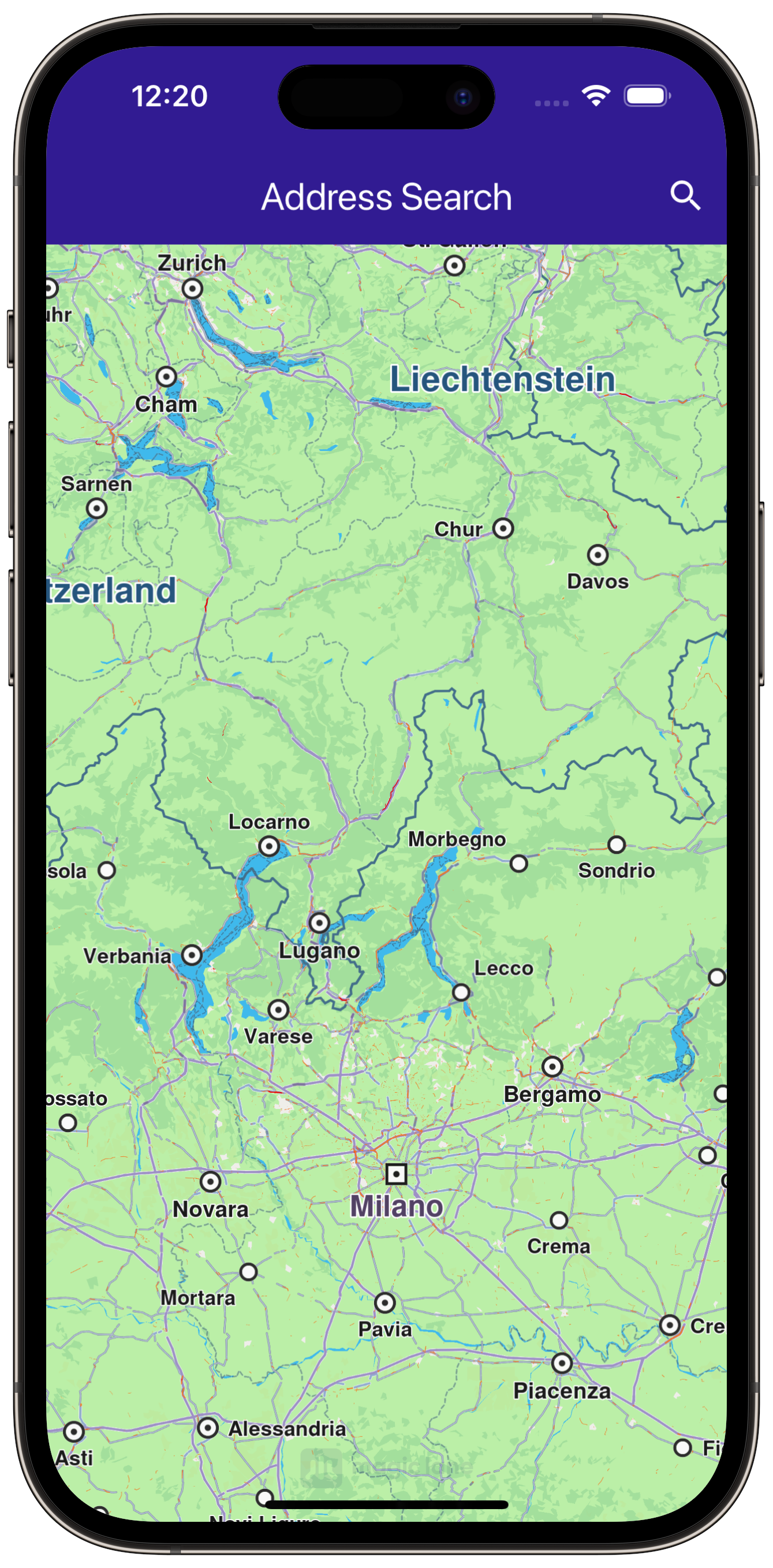Address Search¶
|
|||
Setup¶
Prerequisites¶
Build and Run¶
Navigate to the address_search directory within the Flutter examples directory. This is the project folder for this example.
Note - the gem_kit directory containing the Maps SDK for Flutter
should be in the plugins directory of the example, e.g.
example_pathname/plugins/gem_kit - see the environment setup guide above.
Run: flutter pub get
Configure the native parts:
First, verify that the ANDROID_SDK_ROOT environment variable
is set to the root path of your android SDK.
In android/build.gradle add the maven block as shown,
within the allprojects block, for both debug and release builds:
allprojects {
repositories {
google()
mavenCentral()
maven {
url "${rootDir}/../plugins/gem_kit/android/build"
}
}
}
in android/app/build.gradle
within the android block, in the defaultConfig block,
the android SDK version minSdk must be set as shown below.
Additionally, for release builds, in android/app/build.gradle,
within the android block, add the buildTypes block as shown:
Replace example_pathname with the actual project pathname
android {
defaultConfig {
applicationId "com.magiclane.gem_kit.examples.example_pathname"
minSdk 21
targetSdk flutter.targetSdk
versionCode flutterVersionCode.toInteger()
versionName flutterVersionName
}
buildTypes {
release {
minifyEnabled false
shrinkResources false
// TODO: Add your own signing config for the release build.
// Signing with the debug keys for now, so `flutter run --release` works.
signingConfig signingConfigs.debug
}
}
}
Then run the project:
flutter run --debugorflutter run --release
App entry and initialization¶
const projectApiToken = String.fromEnvironment('GEM_TOKEN');
void main() {
runApp(const MyApp());
}
This code initializes the projectApiToken with the required authorization token and launches the app.
How It Works¶
The example app demonstrates the following features:
Search for a specific address by country, city, street, and house number.
Highlight and center the map on the searched address.
|
|||
UI and Map Integration¶
class MyApp extends StatelessWidget {
const MyApp({super.key});
@override
Widget build(BuildContext context) {
return const MaterialApp(
debugShowCheckedModeBanner: false,
title: 'Address Search',
home: MyHomePage(),
);
}
}
class MyHomePage extends StatefulWidget {
const MyHomePage({super.key});
@override
State<MyHomePage> createState() => _MyHomePageState();
}
class _MyHomePageState extends State<MyHomePage> {
late GemMapController _mapController;
@override
void dispose() {
GemKit.release();
super.dispose();
}
@override
Widget build(BuildContext context) {
return Scaffold(
appBar: AppBar(
backgroundColor: Colors.deepPurple[900],
title: const Text('Address Search', style: TextStyle(color: Colors.white)),
actions: [
IconButton(
onPressed: () => _onSearchButtonPressed(context).then(
(value) => ScaffoldMessenger.of(context).clearSnackBars()),
icon: const Icon(
Icons.search,
color: Colors.white,
))
],
),
body: GemMap(onMapCreated: _onMapCreated, appAuthorization: projectApiToken),
);
}
void _onMapCreated(GemMapController controller) {
_mapController = controller;
}
This code sets up the basic structure of the app, including the map and the app bar. It also provides a search button in the app bar for initiating the address search.
Address Search and Map Interaction¶
Future<void> _onSearchButtonPressed(BuildContext context) async {
_showSnackBar(context, message: "Search is in progress.");
// Predefined landmark for Spain.
final countryLandmark = GuidedAddressSearchService.getCountryLevelItem('ESP');
print('Country: ${countryLandmark.name}');
// Use the address search to get a landmark for a city in Spain (e.g., Barcelona).
final cityLandmark = await _searchAddress(
landmark: countryLandmark,
detailLevel: AddressDetailLevel.city,
text: 'Barcelona');
if (cityLandmark == null) return;
print('City: ${cityLandmark.name}');
// Use the address search to get a predefined street's landmark in the city (e.g., Carrer de Mallorca).
final streetLandmark = await _searchAddress(
landmark: cityLandmark,
detailLevel: AddressDetailLevel.street,
text: 'Carrer de Mallorca');
if (streetLandmark == null) return;
print('Street: ${streetLandmark.name}');
// Use the address search to get a predefined house number's landmark on the street (e.g., House Number 401).
final houseNumberLandmark = await _searchAddress(
landmark: streetLandmark,
detailLevel: AddressDetailLevel.houseNumber,
text: '401');
if (houseNumberLandmark == null) return;
print('House number: ${houseNumberLandmark.name}');
// Center the map on the final result.
_presentLandmark(houseNumberLandmark);
}
void _presentLandmark(Landmark landmark) {
// Highlight the landmark on the map.
_mapController.activateHighlight([landmark]);
// Create an animation (optional).
final animation = GemAnimation(type: AnimationType.linear);
// Use the map controller to center on coordinates.
_mapController.centerOnCoordinates(landmark.coordinates,
animation: animation);
}
// Address search method.
Future<Landmark?> _searchAddress(
{required Landmark landmark,
required AddressDetailLevel detailLevel,
required String text}) async {
final completer = Completer<Landmark?>();
// Calling the address search SDK method.
// (err, results) - is a callback function that gets called when the search is finished.
// err is an error enum, results is a list of landmarks.
GuidedAddressSearchService.search(text, landmark, detailLevel,
(err, results) {
// If there is an error, the method will return a null list.
if (err != GemError.success && err != GemError.reducedResult ||
results!.isEmpty) {
completer.complete(null);
return;
}
completer.complete(results.first);
});
return completer.future;
}
// Show a snackbar indicating that the search is in progress.
void _showSnackBar(BuildContext context,
{required String message, Duration duration = const Duration(hours: 1)}) {
final snackBar = SnackBar(
content: Text(message),
duration: duration,
);
ScaffoldMessenger.of(context).showSnackBar(snackBar);
}
This code enables the app to search for addresses by different levels of detail (country, city, street, house number) and highlights the searched location on the map. The map is centered on the found address, with an optional animation.



